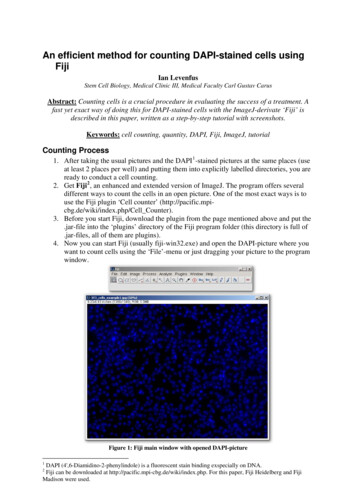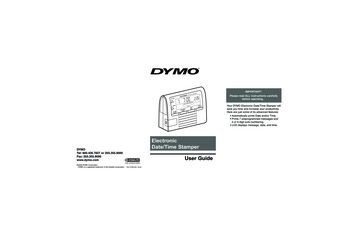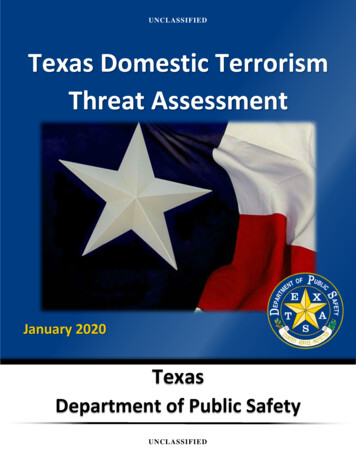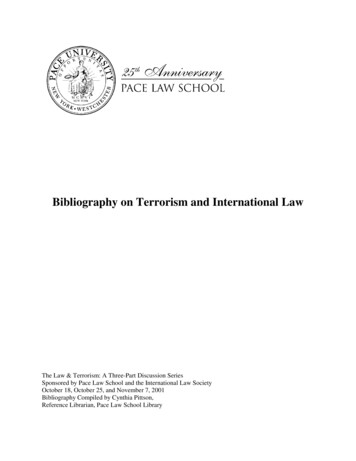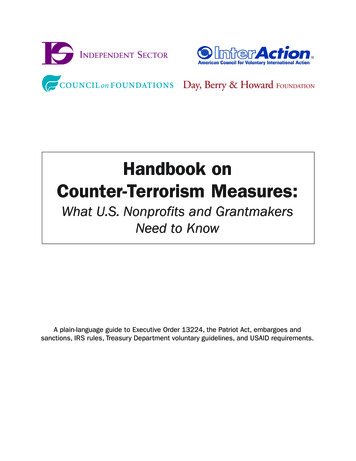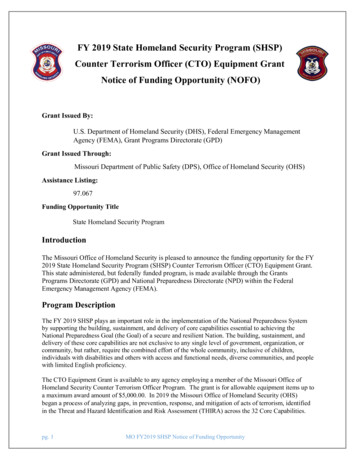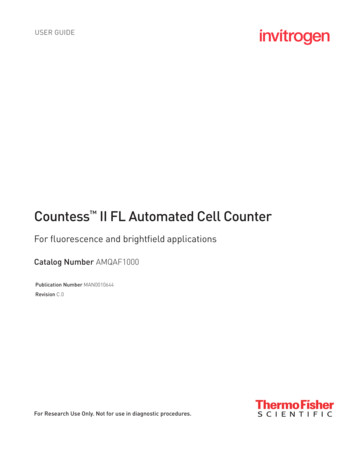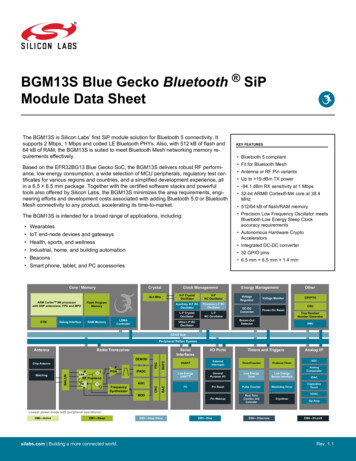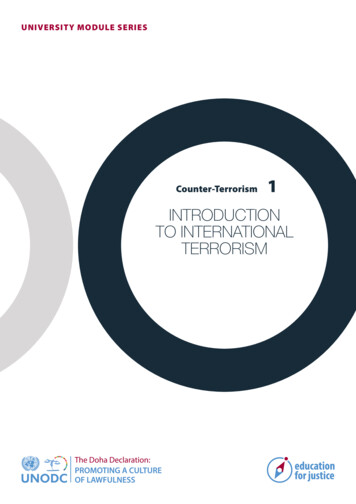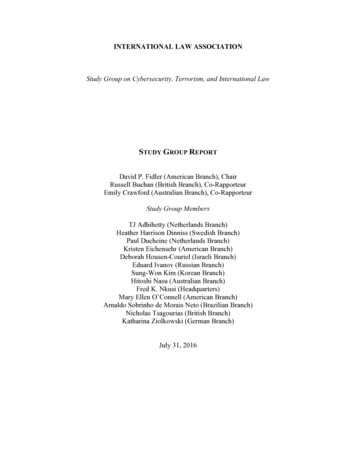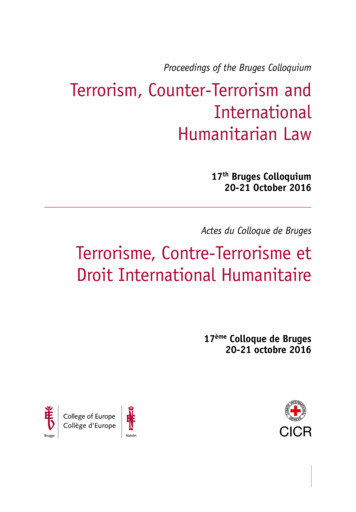
Transcription
Proceedings of the Bruges ColloquiumTerrorism, Counter-Terrorism andInternationalHumanitarian Law17th Bruges Colloquium20-21 October 2016Actes du Colloque de BrugesTerrorisme, Contre-Terrorisme etDroit International Humanitaire17ème Colloque de Bruges20-21 octobre 2016
ICRC Delegation to the EU, NATO and the Kingdom of BelgiumDélégation du CICR auprès de l’UE, de l’OTAN, et du Royaume de BelgiqueGuillaume MullerSous la direction deStéphane KolanowskiMembers of the Editorial Board, College of Europe/Membres du Comité d’édition, Collège d’EuropeLuis Bouza GarcíaAnnelies DeckmynRiccardo TrobbianiDomenico ValenzaNoticeCollegium is the academic journal of the College of Europe. Copyright remains with the authors.The proceedings of this Colloquium have been written by the speakers or by the Delegation of theInternational Committee of the Red Cross (ICRC) in Brussels on the basis of audio recordings ofthe Colloquium. These texts were then reviewed by the speakers. The responsibility of the viewsexpressed in Collegium belongs to the authors. The opinions expressed herein are not necessarilythose of the College of Europe nor the ICRC.AvertissementCollegium est la revue académique du Collège d’Europe. Tous droits réservés. Les Actes de ce Colloque ont été rédigés par les orateurs ou par la Délégation du Comité international de la CroixRouge (CICR) à Bruxelles sur base d’enregistrements audio du Colloque. Ces textes ont alors étérevus par les orateurs. Les opinions exprimées dans Collegium n’engagent que la responsabilitéde leurs auteurs et ne représentent pas nécessairement les vues du Collège d’Europe ou du CICR.
N 47, Autumn/Automne 2017I. PROCEEDINGS OF THE BRUGES COLLOQUIUM/ACTES DU COLLOQUE DE BRUGES p. 5Opening RemarksJörg Monar, Rector of the College of Europe WELCOME ADDRESSWalter Füllemann, Head of the ICRC Delegation to the EU, NATO and the Kingdom of Belgium DISCOURS DE BIENVENUEChristine Beerli, Vice-President of the ICRC KEYNOTE ADDRESSp. 7p. 11Session 1Setting the sceneChairperson: Paul Berman, Legal Service of the Council of the EUSandra Krähenmann, Geneva Academy of IHL and Human Rights LEGAL FRAMEWORK ADDRESSING TERRORISM AND COUNTER-TERRORISMp. 17Tristan Ferraro, ICRC Legal Division INTERACTION AND OVERLAP BETWEEN COUNTER-TERRORISM LEGISLATION AND INTERNATIONALHUMANITARIAN LAWp. 25Gert-Jan van Hegelsom, EEAS Legal Affairs Division p. 31THE EUROPEAN UNION APPROACH TO COUNTER-TERRORISM AND INTERNATIONAL HUMANITARIAN LAWDISCUSSION (EN) p. 39Session 2Legal parameters of the fight against terrorismChairperson: Elzbieta Mikos-Skuza, University of Warsaw and College of EuropeMarco Sassòli, University of Geneva LEGAL QUALIFICATION OF THE FIGHT AGAINST TERRORISMp. 47Rogier Bartels, International Criminal Court TERRORIST GROUPS AS PARTIES TO AN ARMED CONFLICTp. 56Noam Lubell, University of Essex LIMITS OF THE GEOGRAPHICAL SCOPE OF APPLICATION OF IHL IN COMBATING TERRORISMp. 67DISCUSSION (EN) p. 723
Session 3The use of force and other measures of constraint in the fight against terrorismChairperson: Andres Munoz Mosquera, SHAPE Legal OfficeClaire Landais, French Ministry of Defence LEGAL CHALLENGES IN FIGHTING ARMED GROUPS EXTRA-TERRITORIALLYp. 75Françoise Hampson, University of Essex THE CONDUCT OF HOSTILITIES VERSUS THE LAW ENFORCEMENT PARADIGMp. 84Frederik Naert, Legal Service of the Council of the EU and Catholic University of Leuven EU COUNTER-TERRORISM SANCTIONS AND IHL BEFORE THE EU COURT OF JUSTICEp. 92p. 102DISCUSSION (EN) Panel discussionState responses to foreign fighters p. 107Moderator: Elizabeth Wilmshurst, Chatham House Panellists:Vaios Koutroulis, Free University of BrusselsChristophe Paulussen, T.M.C. Asser InstituteChristian Ritscher, German Office of the Federal Public Prosecutor General Session 4Criminalisation of humanitarian action Chairperson: Ann-Kristin Sjöberg, Geneva CallPatrick Duplat, International Rescue Committee IMPACT OF COUNTER-TERRORISM MEASURES ON HUMANITARIAN ACTIONp. 135Dustin Lewis, Harvard Law School HUMANITARIAN EXEMPTIONS FROM COUNTER-TERRORISM MEASURES: A BRIEF INTRODUCTIONp. 141Kim Eling and Maria Lensu, Cabinet of the Commissioner for Humanitarian Aid and Crisis Management HUMANITARIAN ACTION IN TERRITORIES CONTROLLED BY DESIGNATED TERRORIST GROUPS:A DONOR’S PERSPECTIVEp. 151DISCUSSION (EN/FR) p. 157Panel discussionPreventing and countering violent extremism p. 161Moderator: Pascal Daudin, ICRC Policy Cell Panellists:Stephan Husy, Swiss Federal Department of Foreign AffairsDick Clomén, Swedish Red CrossFulco van Deventer, Human Security Collective Concluding Remarks Christine Beerli, Vice-President of the ICRC II. LIST OF PARTICIPANTS/LISTE DES PARTICIPANTS4p. 183 p. 187III. PROGRAMME (EN) p. 195IV. SPEAKERS’ BIOS/BIOGRAPHIES DES ORATEURS p. 198
PROCEEDINGS OF THE BRUGES COLLOQUIUMACTES DU COLLOQUE DE BRUGESOpening RemarksWELCOME ADDRESSJörg MonarRector of the College of EuropeDistinguished guests, dear friends and colleagues, ladies and gentlemen,It is a great pleasure for me to welcome you to this Conference organised by the InternationalCommittee of the Red Cross, together with the College of Europe, on Terrorism, Counterterrorism and International Humanitarian Law (IHL).The challenges, ladies and gentlemen, which terrorism poses to States and societies are daunting, both in their magnitude and in their complexity. In their indiscriminate targeting of innocent civilians, terrorist attacks constitute a challenge for the very fundamentals of humancivilisation and for human intercourse.As terrorists, via their activities, are placing themselves outside the normal standards of human behaviour, there is always a risk that States and other public stakeholders (including international organisations) operate, in their reaction to terrorist attacks, in what may be called“grey zones” of prevention and repression, in which standards of International HumanitarianLaw can be put in danger. As this means potentially adding to the long list of victims of terrorist activities, such risks clearly have to be avoided to the greatest possible extent. This, in thefirst place, for those whose human rights may be endangered by States’ responses. But also,simultaneously for the sake of the legitimacy of States’ action in response to terrorist attacks.I think it is very important to remember that at the height of the aftermath of the September11 attacks that shocked the international community, the United Nations (UN) put a majoremphasis on this challenge. In Security Council Resolution 1456 (2003) and also in severallater resolutions, the UN Security Council has said that States must ensure that any measurestaken to combat terrorism comply with all their obligations under international law and shouldadopt such measures in accordance with international law, in particular International HumanRights standards and IHL.5
So, in spite of the huge pressure on the international community after the international terrorist challenge context of 9/11, a question of how to ensure that human rights standards wouldcontinue to be adhered to has been, right from the start, very high on the agenda.I think that this gives the topic of today’s Conference all of its importance. The College ofEurope is very happy that the International Committee of the Red Cross has chosen the Collegeas a partner to host this important international gathering.Since 1949, it has been enshrined in the College of Europe’s statutes that it must make acontribution to cooperation and integration in Europe, as well as to international cooperationbetween Europe and its partners throughout the world. The College has always endeavoured tomake a positive difference to cooperation across borders, to make a positive contribution tothe coexistence of citizens of different countries. There is here a clear link with the mission ofthe International Committee of the Red Cross, and we are therefore very happy that the RedCross enabled us to fulfil part of our mission through this Bruges Colloquium.I would just like to mention that the College of Europe has this year 463 Master students,of which 330 are here in Bruges and 133 on our second campus in Warsaw, in Natolin. Ourstudents are very enthusiastic and want to make a positive difference to European and international cooperation after they leave the College. Some of the students are here today. I thinkthey are fully aware of the importance of today’s topic. I would also like to mention that thestudents of the College this year come from sixty-one different nations, so they are recruitedfrom well beyond the borders of the European Union. I think we can say that in terms ofinternational outreach, there is some parallelism between the College and the InternationalCommittee of the Red Cross.Lastly, I would like to say that the College has, over the last few years, always had an excellentpractical cooperation with the International Committee. You are one of the most appreciatedpartners in terms of smooth interaction during the preparation of an event, so thank you verymuch also for this.I would then like to hand over to Mr Füllemann, who is Head of the Brussels Office of theInternational Committee of the Red Cross, and will add, from his perspective, further reflections on the subject.Thank you very much.6
DISCOURS DE BIENVENUEWalter FüllemannHead of Delegation, ICRC BrusselsMonsieur le Recteur, Madame la Vice-présidente, Excellences, Mesdames et Messieurs,J’ai le grand plaisir de vous accueillir, au nom du Comité international de la Croix-Rouge(CICR), au 17ème Colloque de Bruges qui porte sur « Le terrorisme, le contre-terrorisme et ledroit international humanitaire ».Le titre du Colloque, en soi, pourrait déjà prêter à discussion, tant il est vrai que, par essence,le terrorisme est la négation même des principes qui sous-tendent le droit international humanitaire (DIH) et qu’il s’oppose aux objectifs mêmes que le DIH poursuit. Mais le terrorisme faitaussi partie du paysage des conflits armés, et à ce titre côtoie le DIH de plusieurs manières.Le phénomène n’est pas nouveau, loin de là Le terrorisme lié aux conflits armés existedepuis bien longtemps. On le retrouve lorsque des autorités qualifient leurs opposants de« terroristes », ou encore, dans ce que l’on appelle aujourd’hui des « guerres asymétriques »,lorsque des parties aux conflits armés utilisent des méthodes destinées à semer la terreur, ou,enfin, lorsque des conflits armés sont une des formes que prend la réaction des Etats ou desorganisations internationales à certaines attaques terroristes, comme par exemple le confliten Afghanistan depuis 2001.Ce qui est nouveau, en revanche, c’est l’environnement dans lequel ces phénomènes se développent. L’environnement opérationnel, l’environnement politique, l’environnement technologique, l’environnement juridique mais aussi l’environnement socio-économique ont profondément évolué ces vingt dernières années et ont profondément modifié tant la manière dontopèrent les groupes qualifiés de « terroristes » que la manière dont réagissent les autoritésnationales ou les organisations internationales.L’environnement politico-opérationnel a en effet énormément changé et l’on se retrouve aujourd’hui avec plusieurs théâtres d’opération qui voient s’affronter des forces armées étatiquesà des groupes armés non étatiques dont bon nombre se retrouvent sur des listes d’organisations terroristes établies par des Etats ou des organisations internationales, telles que lesNations unies ou l’Union européenne (UE). Par ailleurs, ces conflits armés peuvent parfoiss’exporter, généralement sous des formes d’actes qualifiables de « terroristes », comme parexemple les attaques du 13 novembre 2015 à Paris ou du 22 mars 2016 à Bruxelles, pour ne7
citer que celles qui ont récemment touché des Etats de l’UE. Notons, par ailleurs, que d’autresrégions du monde sont bien plus touchées par ce phénomène que ne l’est l’Europe.Cette « exportation » de la violence est largement facilitée par les technologies de l’information, et ce à plusieurs niveaux. D’une part celles-ci permettent un plus large ralliement à une« cause » et des contacts d’un bout à l’autre de la planète de manière instantanée et discrète.Mais, d’autre part, cela permet aussi de trouver facilement toute l’information nécessaire à lapréparation d’actions violentes et d’en assurer une certaine publicité.Face à ce contexte difficile, de nombreux Etats et des organisations internationales ont étéappelés à réagir, y compris sur le plan législatif. C’est bien entendu sur ces aspects-là que nousallons nous concentrer pendant ces deux jours, du moins sur ceux qui peuvent avoir un impactsur le droit international humanitaire et sur les activités humanitaires.Depuis quelques années, le CICR s’est impliqué dans le débat relatif à l’équilibre entre la luttecontre le terrorisme et le DIH car il a pu constater certaines dérives et certains risques poséstant au respect des droits fondamentaux qu’au respect de l’action humanitaire. Au débutdu mois d’octobre, à la tribune de la 6ème Commission de l’Assemblée générale des NationsUnies, le CICR rappelait que « the ICRC does not challenge the legitimacy of States to takemeasures necessary to ensure their security and eliminate terrorism. Nevertheless, when suchmeasures are taken, the safeguards protecting human life and dignity must be upheld ». Cettephrase résume la position du CICR, partagée par un bon nombre d’organisations humanitairesou de défense des droits de l’homme, ainsi que par une majorité d’Etats. La difficulté estdonc de trouver le meilleur équilibre possible entre la préservation de la vie et de la dignitéhumaine d’une part et les impératifs de sécurité d’autre part. Une recherche d’équilibre quel’on retrouve, mutatis mutandis, dans l’essence même du DIH qui repose sur l’équilibre entreles considérations d’humanité et les nécessités militaires Certaines activités d’organisations humanitaires impartiales, telle que le CICR, risquent, parfois, d’être considérées comme activités soutenant un groupe qualifié de « terroriste », et dèslors considérées comme criminelles. Cela peut aller du simple contact et networking parmices groupes – ce qui est indispensable pour assurer un accès aux populations victimes desconflits armés qui se trouvent dans un territoire sous le contrôle de ces groupes – à l’assistance médicale apportée à leurs combattants. On a même vu que des activités de diffusiondu droit international humanitaire pouvaient être considérées comme illégales selon certaineslégislations nationales, ce qui est un comble sachant que le but même de cette diffusion estd’obtenir un comportement plus respectueux de la vie et de la dignité humaine par les partiesaux conflits. Madame Beerli reviendra sur ces points dans un instant, et nous aurons un jouret demi pour en discuter.8
Les habitués du Colloque de Bruges l’auront remarqué : nous sommes un peu plus serrés qued’habitude dans la salle. En effet, ce 17ème Colloque de Bruges a rencontré un tel succès quenous battons tous nos records en termes de participation. Cela démontre la justesse du choixdu thème et l’importance que celui-ci revêt pour vos Etats ou vos organisations internationales, régionales ou non gouvernementales.A l’heure même où nous parlons, le Conseil de l’Union européenne, la Commission et le Parlement européen sont d’ailleurs réunis en « trilogue », dans la phase finale de rédaction de lanouvelle Directive de l’UE sur la lutte contre le terrorisme. Il s’agit pour l’UE d’actualiser cequi était précédemment une Décision-cadre adoptée en 2002 et amendée en 2008. Mais entre2002 et 2016, le monde a connu bien des évolutions, qui ont eu un impact sur les groupesterroristes et sur la lutte contre le terrorisme. Le CICR est confiant que cette future directiveconservera une clause de sauvegarde du droit international humanitaire et préservera l’actionhumanitaire de toute criminalisation.Il est évident pour tous que nous souhaitons éviter que nos activités humanitaires soient criminalisées. Mais il est tout aussi essentiel que ceux qui combattent en respectant les normesdu droit international humanitaire ne soient pas automatiquement poursuivis pour fait deterrorisme. Cela permet d’une part d’éviter un conflit entre différentes normes juridiques, etd’autre part d’inciter les parties non étatiques aux conflits armés à mieux respecter le DIH. Ilne s’agit pas de légaliser ce qui serait illégal par ailleurs, mais, au contraire, d’éviter de rendreillégal un comportement qui serait légal au regard du DIH.Le Collège d’Europe et le CICR sont très heureux de vos réponses si nombreuses à notre invitation à discuter de cette thématique délicate. C’est en effet devenu une tradition que nousnous retrouvions à Bruges tous les troisièmes jeudis et vendredis d’octobre pour discuter dequestions difficiles de DIH dans une atmosphère constructive. Nous n’allons pas déroger àcette tradition cette année, et espérons que ce 17ème Colloque nous permettra à tous demieux définir certains concepts, ainsi que de trouver l’articulation la plus appropriée entreceux-ci, de façon à aboutir à de solides pistes vers la meilleure réponse possible au terrorisme.Cette « meilleure réponse possible » a d’ailleurs été joliment décrite, il y a plus de 60 ans déjà,par Albert Camus lorsqu’il écrivait dans ses Chroniques qu’ « il s’agit de servir la dignité del’homme par des moyens qui restent dignes au milieu d’une histoire qui ne l’est pas ».Avant de céder la parole à Madame Christine Beerli, Vice-présidente du CICR, je voudraisremercier nos orateurs et modérateurs d’avoir accepté de venir partager leurs expertises etconfronter leurs idées lors de ce Colloque. Je voudrais également remercier notre partenaire,le Collège d’Europe, non seulement pour son hospitalité dans cette belle ville de Bruges, mais9
également, voire surtout, pour la confiance que le Collège nous a renouvelée cette annéeencore tant pour le Colloque annuel que pour les cours de DIH dispensés aux étudiants desdeux campus du Collège. C’est un réel plaisir de travailler avec cette institution académique sisérieuse, professionnelle, respectueuse et ouverte.Last but not least, je souhaite vivement remercier l’équipe de la délégation de Bruxelles qui aorganisé ce Colloque ainsi que nos interprètes qui nous soutiennent depuis des années pourque la langue de Molière puisse continuer à vivre dans cette salle.Mesdames et Messieurs, je me réjouis d’avance des débats que nous allons partager pendantces deux jours qui s’annoncent très stimulants et je vous remercie de votre intérêt et de votreparticipation. Je vous souhaite un bon colloque.10
KEYNOTE ADDRESSChristine BeerliVice-President of the ICRCLadies and gentlemen,It is a great pleasure to be with you at the 17th edition of the Bruges Colloquium and to havethe privilege of making a few introductory remarks on the topic that we will be focussing onfor the next two days. The chosen theme – Terrorism, Counter-terrorism and International Humanitarian Law – is very timely: it will allow us to look at some of the fundamental legal andoperational questions raised by the ongoing fight against terrorism.Terrorism is a scourge to which the international community has been striving to respond fordecades. The obvious challenges it poses are both long-lasting and immediate. Wherever weturn around the world these days, we are confronted with increased risks of terrorist acts. Terrorism is a global phenomenon which the international community is increasingly facing andwhich is often closely linked to armed conflict.Terrorism negates the fundamental principles of humanity as well as the essential principlesand objectives of International Humanitarian Law (IHL). In this regard, the InternationalCommittee of the Red Cross (ICRC) condemns acts of terrorism, irrespective of their perpetrators, be they committed in or outside an armed conflict, and is deeply distressed by theirdevastating impact on communities and individuals.Every day we see the dramatic consequences of the fight between States and non State armedgroups designated as terrorist, in particular in Africa and in the Levant. Irrespective of theclaimed legitimacy of this fight or the causes espoused by or attributed to those involvedtherein, what we observe in the field is once again the civilian population bearing the bruntof armed violence. Cities are reduced to rubble, civilians are directly attacked, humanitarianand medical personnel, transports and infrastructures are targeted and prevented from fulfilling their functions, the civilian population is deprived of supplies essential for its survivalthrough siege warfare and humanitarian access is denied. Resulting from all of this, hundredsof thousands of people are internally displaced or have fled their country, leaving a home, ajob, a plot of land, or even close relatives behind. In the absence of a political solution, compliance with IHL and the fundamental values underpinning this body of law is required morethan ever, from all sides, because the prohibition of acts of terrorism and other violations ofthe law is not just binding on non-State armed groups.11
Ladies and gentlemen,The rise of non-State armed groups resorting to acts of terrorism is a growing concern domestically but also internationally. This situation has led States and international organisations toreact by tightening existing counter-terrorism measures and introducing new ones. Of course,the ICRC does not challenge the necessity for States to take legitimate measures to ensuretheir security. Nonetheless, when States take such measures to eliminate terrorism, the safeguards protecting human life and dignity must be upheld. In the ICRC’s view, the internationalcommunity must be clear and firm on the need for counter-terrorism activities to be conductedin full respect of the protection afforded to all individuals by international law, in particularIHL and Human Rights Law. Such respect is in the interest of the international community, asthere is today growing recognition that violations of these bodies of international law may inturn exacerbate the very phenomenon that counter-terrorism purports to fight.Neither armed conflict nor terrorism are new forms of violence. Both have existed for a longtime and have, for the most part, been understood as separate issues, as demonstrated bythe different legal frameworks that regulate them. The perception that armed conflict andterrorism differ and that their respective legal rules are distinct has radically changed sinceSeptember 2001 and the subsequent launching of a “global war on terrorism”. Recent yearshave again seen the rise of non-State armed groups resorting to acts of terrorism and thesubsequent engagement of a coalition of States against them. This situation has put therelationship between IHL and the legal framework governing terrorism back into the spotlightand may have even created the perception that there may be a new “global war on terrorism”involving a group or groups of unbounded geographical reach.The recent actions taken by States against non-State armed groups designated as terroristand the correlative counter-terrorism discourse in both domestic and international fora havesignificantly contributed to a blurring of the lines between armed conflict and terrorism andtheir respective legal frameworks. This is further exacerbated by the fact that, often, counterterrorism instruments include situations of armed conflict in their scope of application. Theresultant overlaps and contradictions between IHL and the legal instruments specifically designed to address terrorism are problematic. Counter-terrorism norms may interfere with IHLregulation of armed violence, notably by prohibiting conduct that is not unlawful under IHL,creating legal confusion and potentially adversely affecting some of the underlying principlesof IHL. In this regard, one should carefully study the consequences of such interference andseek creative ways to ensure the integrity of IHL, thereby maintaining its rationale – which isneeded more than ever in current armed conflicts.12
Ladies and gentlemen,The fight against terrorism may take various forms, including armed conflict. Determiningwhen IHL applies to particular counter-terrorism activities is not an easy enterprise. Not onlybecause some States may tend to deny the applicability of IHL on the basis that non-Statearmed groups designated as terrorist organisations cannot be considered party to an armedconflict. How, when and where IHL applies to counter-terrorism activities still raises importantlegal questions.First of all, it is important to recall that any use of force against non-State armed groupsdesignated as terrorist – or against members and affiliates thereof – is not necessarily synonymous with a situation of armed conflict governed by IHL. When armed force is used, onlythe facts on the ground are relevant for determining the legal classification of a situationof violence. Some situations may be classified as international armed conflicts, others asnon-international armed conflicts, while various acts of violence may fall outside any armedconflict due to lack of the requisite nexus. In the ICRC’s view, this is also true for the fightagainst terrorism.Another crucial question relating to IHL applicability is whether non-State armed groups designated as terrorist fulfil the organisation criterion for classifying a situation as a non-international armed conflict. This is all the more difficult in view of the myriad of fluid, multiplyingand fragmenting armed groups that frequently take part in the fighting. Often, their structureis difficult to understand. In some cases, some form of leadership structure emerges at somepoint, claiming to unite different armed groups, often based on pledges of allegiances. Thisraises the question of what link needs to exist between different armed groups in order toconsider formerly distinct entities as one party to an armed conflict. The same question alsoemerges with regard to different groups that join forces transnationally, such as differentarmed groups pledging allegiance to the Islamic State group or to Al Qaida.The spillover of conflicts into neighbouring countries, their geographical expanse and theirregionalisation also appear to have become distinctive features of many contemporary armedconflicts involving non-State armed groups designated as terrorist. The transnational natureof such armed conflict involving a non-State armed group capable of operating in variouscountries – even non-contiguous ones – directly raises the question of IHL’s territorial reach.This is still a much-debated area of the law – in particular when it comes to the applicabilityof IHL for military operations in the territory of non-belligerent States – that will certainlybenefit from your insights.13
Ladies and gentlemen,Our discussions will also allow us to examine whether IHL is a relevant body of law – when theconditions for its applicability are met – for those engaged in the fight against terrorism. IHLhas sometimes been described – wrongly in the ICRC’s view – as a set of rules which hindersthe efforts of States to efficiently address their security concerns and fails to provide adequatetools to deal with non-State armed groups designated as terrorist. I am confident that we willbe able to dispel some misconceptions in this regard and highlight the fact that, in situationsof armed conflict, IHL should not be considered as an obstacle to the fight against terrorism.On the contrary, IHL can be a powerful tool at States’ disposal while still providing importantprotections – complemented by Human Rights Law – for those affected by the armed conflictbetween States and non-State armed groups designated as terrorist. This added value of IHLis significant in the fields of the use of force and detention.The number of the ‘foreign fighters’ – nationals of one country who travel abroad to fightalongside a non-State armed group in the territory of another State – has increased exponentially over the past few years. In order to quell the threats emanating from foreign fighters,States - in particular within the framework of the United Nations (UN) Security Council - havetaken a variety of measures, including the use of force, detention (on terrorism charges,among others), and travel bans.While most of the measures taken to prevent individuals from joining non-State armed groupsor to mitigate the threat they may pose upon return are of a law enforcement nature, the applicability of IHL, where appropriate, should not be overlooked. However, so far, little attention has been paid to how IHL deals with foreign fighters.The concept of “foreign fighter” is not a term of art in IHL. The general applicability of IHLto a situation of violence in which such fighters may be engaged does not depend on the nationality of those fighting. It depends only on the facts on the ground and on the fulfilmentof certain legal conditions stemming from the relevant norms of IHL, in particular commonArticles 2 and 3 of the Geneva Conventions. In other words, in situations of armed conflict,IHL will govern the actions of foreign fighters, as well as any actions against them by partiesto that conflict, when such actions have a nexus to the armed conflict concerned.In this regard, it is important to underline that foreign fighters detained in relation to anarmed conflict to which the detaining authorities are party must benefit from the protections afforded by the applicable IHL rules, irrespective of the domestic laws that also governtheir detention. Unfortunately, States dealing with foreign fighters tend to shy away from14
recognising the applicability of IHL to their detention. Our discussions will certainly allow usto understand why this is so and to clear up the misapprehension that IHL wou
Marco Sassòli, University of Geneva p. 47 LEGAL QUALIFICATION OF THE FIGHT AGAINST TERRORISM Rogier Bartels, International Criminal Court p. 56 TERRORIST GROUPS AS PARTIES TO AN ARMED CONFLICT Noam Lubell, University of Essex p. 67 LIMITS OF THE GEOGRAPHICAL SCOPE OF APPLICATION OF IHL IN COMBATING TERRORISM DISCUSSION (EN) p. 72
